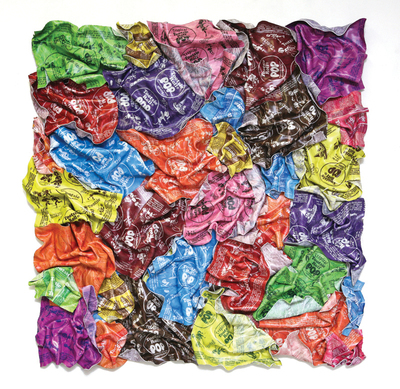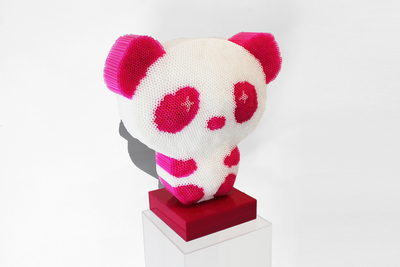A Moveable Feast

Paul Rousso, Pop Art, 2015, mixed media on hand sculpted acrylic, 48 x 48 x 7″. Photo: Paul Rousso.
Over the past fifteen years, a grim stretch of abandoned factories in Boston’s South End has morphed into a burgeoning mecca of fine art, with dozens of street-level galleries in converted factories on Harrison Avenue and Thayer Street and dozens more artist studios in the floors above, all open to the public. “People get overwhelmed when they come here,” says oil painter Stephen Silver. “They say, ‘We had no idea all of this was down here.’ In one or even three visits, it’s hard to take in all the art in SoWa.” Short for South of Washington Street, SoWa is an eclectic mix of retail, restaurants and high-end condos and apartments defined today by its exploding art scene.
The growth of the artists’ haven was “just an accident,” says GTI Properties president Mario Nicosia, the developer primarily responsible for SoWa’s transformation. While the rest of the South End began to flourish in the 19th century with Victorian homes, the area now known as SoWa was filled with piano, canned goods, and shoe factories through the middle of the 20th century. When Nicosia bought his first property in the area, the four-story brick factory at 460 Harrison Avenue, in 1978, the building had been unoccupied for more than two decades. “Industrial tenants weren’t coming back,” he says. “So I had to subdivide the building into much smaller spaces. As it turned out, artists wanted to move in.” Rent was cheap—the area was desolate. “Through the ’80s, you could walk along Harrison for three blocks and see no one.” If you did, it was most often a homeless person walking to or from the Pine Street Inn, one of Boston’s most respected shelters. Slowly, beginning in the 1990s, growing numbers of potters and painters rented out studio spaces. But Silver said that even when he moved into his studio in 2004—after retiring as a technology executive—“The area was pretty sketchy, and 460 Harrison was an empty, disgusting, shambles of a place.”
A view of Fernando DeOliveira Studio.
Nicosia coined the term “SoWa” in 2000, as a marketing tool. “If I tried to get the city or the neighborhood to approve it,” he says, “we’d still be waiting on it today.” Because SoHo bears so much cache, “designating an area ‘So’ tells people that this is a destination for art.” As Nicosia built and renovated more than a million square feet of property in SoWa, local businesses with flair such as men’s vintage fashion shop Bobby from Boston and exotic home furnishings retailer Mohr & McPherson (which includes a showroom with more than $2 million worth of rugs) began moving in. As Mohr & McPherson curator Cal McPherson said, unlike recent developers in once-hotspots such as Harvard Square, who have allowed “a place to go from the coolest vibe in New England to basically a place to buy cellphones,” Nicosia has remained selective about whom to rent, “to ensure the area remains edgy.” Slowly, SoWa has also become a gourmand’s hamlet, with the brasserie Gaslight, modern comfort food at The Gallows, and its artisanal pastry shop Blackbird Donuts, which opened earlier this year. As foot traffic grew and SoWa developed a recognizable character, the artist community expanded, and artists began to sell their work directly from their studios.
Since Stephen Silver founded the SoWa Artists Guild in 2005, membership has grown from 20 to more than 70 artists. The critical mass works in upstairs studios at 450 Harrison, mostly mid-career artists from across the globe geographically and artistically, like Barbara Goldberg, who designs hand-crafted polymer clay beads, and politically charged line-drawing artist Brian Murphy, and expressionist painter and Peru native Elena Francesca du Plessis. Brazilian abstract painter and sculptor Fernando DeOliveira, who has sold his works from his studio at 460 Harrison since he arrived 2003, says the artists’ colony is a “perfect scenario.” For one, he says patrons can only find this dense a concentration of artists selling their own work directly in Miami or San Diego. “But the best part is the direct feedback from collectors and the public in general,” he says. “Unlike friends, people who come by and knock on your door are very straightforward about what they think of your work, as you’re working. Sometimes they’ll say, ‘Wow, that sucks.’” Between passersby on weekdays and the 800 to 900 who visit on First Fridays, more than 80,000 people have visited their studios since 2005, including more than 10,000 this year alone.
Sofia Bennani and Alexandra Singer-Bieder (Straw-K), Panda PW, 2015, fused straws on fixed plexiglass, 19 3/5 x 21 7/10 x 9 1/10″. Photo: Straw-K. Courtesy of Abigail Ogilvy Contemporary Art.
As the artists have multiplied upstairs at 450 and 460 Harrison, galleries have grown below and along Thayer Street. Today there are more than 30, from Gallery Kayafas with wide-ranging photography exhibitions to Boston Sculptors Gallery. Many artists, including Silver, have begun to purchase their own galleries. DeOliveira’s new gallery will open with a show of his own work in October, and, beginning with a photography group show in January 2016, serve as a “platform for friends who have never had a chance to do a show before. It’s just going to add to the year-round party in SoWa.”
For as much as artists, gallerists and retailers have transformed SoWa on their own with First Friday exhibitions and open studios, surging rent-increases on Newbury Street have also fueled a great migration. Deep-pocketed chain stores have been pushing Newbury Street galleries and local vendors alike to smaller spaces and upper floors for decades. In the last eight years alone, nearly a dozen galleries—most of them contemporary American, such as the Miller Yezerski Gallery (now at 460 Harrison) and Chase Young (450 Harrison)—have relocated into much more affordable and grander spaces in SoWa. Nicosia says he has kept rent “leaps and bounds” below any other gallery spaces in the city. Among the satisfied emigrants is Susan Lanoue. After a decade of paying for ever-rising rent for her 1,000-square-foot contemporary gallery on Newbury Street (rent doubled when a new developer bought her building in 2013), Lanoue moved in spring 2014 to 450 Harrison. “I couldn’t have ordered up a better gallery space if you gave me carte-blanche,” Lanoue says of the new 4,000-square-foot space with high ceilings and ample light. The new locale has already bestowed numerous benefits. For one, on Newbury, Lanoue felt more or less obligated to bring in more traditional works that she knew would sell and keep her afloat. “Now we can afford to take more risks artistically,” she says. For example, on September 4, Lanoue is opening an exhibition featuring 15 of Charlotte, North Carolina-based pop artist Paul Rousso’s three-dimensional, hand-sculpted acrylics—including four-by-eight-foot rumpled, elephantine candy wrappers and a $5,000 bill. She said she never would have brought his work to Newbury Street. “Not only did we not have the space, we also couldn’t afford to hope that people would fall in love” with work so experimental. But Rousso’s work, she says, “takes people’s breathe away. People are going to go, ‘Oh my God. How did he create this?’” With the additional space, Lanoue was also able to bring in eight new artists this year, more than quadruple what she normally adds. Among them are Peter Combe, who creates three-dimensional works—usually portraits—out of paint swatches hand-punched at angles; and Sherry Karver, who superimposes short biographies onto her photographic subjects.
Ali Cavanaugh, Prayer, 2015, watercolor on clayboard, 18 x 24″. On view in Immerse: New Watercolors by Ali Cavanaugh at Gold Gallery, September 8–October 18, 2015.
Spread up and down the two miles of Newbury Street, gallerists rarely interacted. Now, concentrated within a couple of blocks, gallerists often drop in on each other, and know exactly which works each other is exhibiting. “Now it’s much easier for me to [walk one of my clients over to another gallery], and for other gallerists to do the same for me,” says Lanoue. And when independent art consultants take clients, they can park once and visit a dozen galleries.
The tide continues to rise. After 25 years on Newbury Street, Beth Urdang will relocate her gallery of modernist American paintings to an 850-square-foot space at 450 Harrison Ave. this fall (her gallery in Wellesley, MA, will remain open). With so many fellow gallerists and artists now in SoWa, she says, “It feels a little like coming home.” The Beth Urdang Gallery will open on November 6, tentatively with an exhibition from Alex Katz (whose paintings she has previously showcased).
And when six more galleries open this fall in the back of 460 Harrison (Mohr & McPherson moved its warehouse from there last year), SoWa will boast more galleries than Newbury Street. The newcomers include T + H Gallery (contemporary mixed media), Abigail Ogilvy Gallery (featuring early-career American contemporary artists), and Gold Gallery. Founded by thirty-something entrepreneur Adam Gold (a native of Western Massachusetts), Gold Gallery will open its new space in October after its final show on nearby Tremont Street, Immerse (September 8–18), a series of St. Louis artist Ali Cavanaugh’s watercolor portraits of her young daughter. T + H, directed by Beijing native Ting Liu (her husband Zihao Chen is the associate director), will open in November with Typology Morphology, a group show highlighting digital media created at Alfred, New York’s Institute for Electronic Arts since its founding in 1997. Abigail Ogilvy, a Dartmouth graduate and former assistant curator of Galleria Tornabuoni in Florence, will open her gallery (depending on when construction finishes) in October or November with a showcase of recent Boston University MFA graduate Keenan Derby, whose large-scale abstract statement pieces take three to four months to craft. Ogilvy’s future featured artists range from Polish-American watercolorist Natalia Wrobel to Concord native Holly Harrison, who creates collages out of handwriting samples, photographs, and Japanese and Indian printed papers.
A view of Lanoue Gallery’s recent exhibition Christine Vaillancourt & KX2.
“It goes without saying today that SoWa is the art destination in Boston,” Ogilvy said. Foot traffic continues to swell and more high-end local retailers (including A Street Frames) and two new luxury apartment buildings open this fall: Ink Block on Harrison, located above a new Whole Foods, and the 378-unit Troy Boston on Traveler Street. But perhaps no transformation in the area outpaces the artists’ studios. After you’ve spent three visits roaming around the workshops of the still life painters, the potters, and the sculptors, you may have to return to see the new artists who have since moved in—there’s currently a two-year waiting list for studio space at 450 Harrison. As Cal McPherson said, SoWa is now much more than a marketing device. “SoWa today has a distinct character, a buzz and a passion for design unlike anywhere else in the city.”
Zachary Jason is a Boston-based writer who is a regular contributor to Boston Magazine and Boston College Magazine.




